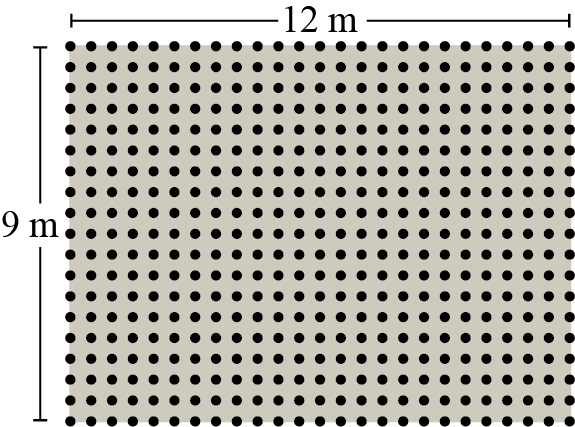

Sadie has garden beds that are \(11\) m by \(14\) m. She wants to grow giant sunflowers in one of her garden beds and dwarf sunflowers in another garden bed.
Sadie spaces the giant sunflower seeds \(50\) cm apart, in rows that are \(50\) cm apart, leaving a \(100\) cm border on all sides of the garden bed. How many giant sunflower seeds can she plant in one garden bed?
In another garden bed, Sadie plants dwarf sunflower seeds. She spaces the seeds \(25\) cm apart, in rows that are \(25\) cm apart, leaving a \(100\) cm border on all sides of the garden bed. How many dwarf sunflowers can she plant in this garden bed?
All of Sadie’s sunflowers have germinated and matured, but then in a cold early frost one evening, she loses \(20\%\) of the giant sunflowers and \(10\%\) of the dwarf sunflowers. If Sadie sells all the surviving sunflowers at \(\$5.00\) each for the giants and \(\$3.00\) each for the dwarfs, which crop will provide the greater income?

Since \(100\) cm is equal to \(1\) m, the border around Sadie’s garden bed is \(1\) m on each side. That means the planting area inside the garden is \(9\) m by \(12\) m. If she plants rows of seeds starting right on the edge of the planting area, and plants them \(50\) cm (or \(\frac{1}{2}\) m) apart, then in each row she can plant \(2\) seeds per metre, plus \(1\) more seed at the end of the row. So, along the \(9\) m width she can plant \(9 \times 2 +1=18+1=19\) seeds. Along the \(12\) m length she can plant \(12 \times 2 + 1 = 24 + 1 = 25\) seeds. Thus, Sadie can plant a total of \(19 \times 25 = 475\) giant sunflower seeds in one garden bed, as shown.

As in part (a), we can conclude that the planting area inside this garden bed is also \(9\) m by \(12\) m. If Sadie plants rows of seeds starting right on the edge of the planting area, and plants them \(25\) cm (or \(\frac{1}{4}\) m) apart, then in each row she can plant \(4\) seeds per metre, plus \(1\) more seed at the end of the row. So, along the \(9\) m width she can plant \(9 \times 4 +1=36+1=37\) seeds. Along the \(12\) m length she can plant \(12 \times 4 + 1 = 48 + 1 = 49\) seeds. Thus, Sadie can plant a total of \(37 \times 49 = 1813\) dwarf sunflower seeds in this garden bed.
After the loss of \(20\%\) of the giant sunflowers, Sadie will have \(80\%\) of \(475\), or \(0.8 \times 475 =380\) flowers left. These giant sunflowers will provide an income of \(380\times \$5.00=\$1900\).
After the loss of \(10\%\) of the dwarf sunflowers, Sadie will have \(90\%\) of \(1813\), or \(0.9 \times 1813\approx 1632\) flowers left. These dwarf sunflowers will provide an income of \(1632\times \$3.00=\$4896\). Thus, the income from the dwarf sunflowers is more than double that of the giant sunflowers.